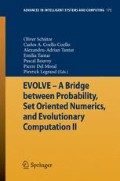Abstract
Stereo vision is one of the most active research areas in modern computer vision. The objective is to recover 3-D depth information from a pair of 2-D images that capture the same scene. This paper addresses the problem of dense stereo correspondence, where the goal is to determine which image pixels in both images are projections of the same 3-D point from the observed scene. The proposal in this work is to build a non-linear operator that combines three well known methods to derive a correspondence measure that allows us to retrieve a better approximation of the ground truth disparity of stereo image pair. To achieve this, the problem is posed as a search and optimization task and solved with genetic programming (GP), an evolutionary paradigm for automatic program induction. Experimental results on well known benchmark problems show that the combined correspondence measure produced by GP outperforms each standard method, based on the mean error and the percentage of bad pixels. In conclusion, this paper shows that GP can be used to build composite correspondence algorithms that exhibit a strong performance on standard tests.
Access this chapter
Tax calculation will be finalised at checkout
Purchases are for personal use only
Preview
Unable to display preview. Download preview PDF.
References
Birchfield, S., Tomasi, C.: Depth discontinuities by pixel-to-pixel stereo. Int. J. Comput. Vision 35(3), 269–293 (1999)
Brown, M.Z., Burschka, D., Hager, G.D.: Advances in computational stereo. IEEE Trans. Pattern Anal. Mach. Intell. 25(8), 993–1008 (2003)
Cagnoni, S., Lutton, E., Olague, G.: Genetic and Evolutionary Computation for Image Processing and Analysis. In: EURASIP Book Series on Signal Processing and Communications, vol. 8. Hindawi Publishing Corporation (2008)
Ebner, M.: A real-time evolutionary object recognition system. In: Vanneschi, L., Gustafson, S., Moraglio, A., De Falco, I., Ebner, M. (eds.) EuroGP 2009. LNCS, vol. 5481, pp. 268–279. Springer, Heidelberg (2009)
Hernández, B., Olague, G., Hammoud, R., Trujillo, L., Romero, E.: Visual learning of texture descriptors for facial expression recognition in thermal imagery. Computer Vision and Image Understanding, Special Issue on Vision Beyond the Visual Spectrum 106(2-3), 258–269 (2007)
Howard, D., Roberts, S.C., Brankin, R.: Target detection in sar imagery by genetic programming. Advances in Engineering Software 30(5), 303–311 (1999)
Koza, J.: Human-competitive results produced by genetic programming. Genetic Programming and Evolvable Machines 11(3), 251–284 (2010)
Koza, J.R., Keane, M.A., Yu, J., Forrest, I., Bennett, H., Mydlowec, W.: Automatic creation of human-competitive programs and controllers by means of genetic programming. Genetic Programming and Evolvable Machines 1(1-2), 121–164 (2000)
Koza, J.R., Streeter, M.J., Keane, M.A.: Routine high-return human-competitive automated problem-solving by means of genetic programming. Information Sciences 178(23), 4434–4452 (2008)
Krawiec, K.: Genetic programming-based construction of features for machine learning and knowledge discovery tasks. Genetic Programming and Evolvable Machines 3(4), 329–343 (2002)
Krawiec, K., Bhanu, B.: Visual learning by coevolutionary feature synthesis. IEEE Transactions on Systems, Man, and Cybernetics, Part B 35(3), 409–425 (2005)
Olague, G., Trujillo, L.: Evolutionary-computer-assisted design of image operators that detect interest points using genetic programming. Image Vision Comput. 29(7), 484–498 (2011)
Pérez, C.B., Olague, G.: Learning invariant region descriptor operators with genetic programming and the f-measure. In: 19th International Conference on Pattern Recognition (ICPR 2008), Tampa, Florida, USA, December 8-11, pp. 1–4. IEEE (2008)
Perez, C.B., Olague, G.: Evolutionary learning of local descriptor operators for object recognition. In: GECCO 2009: Proceedings of the 11th Annual Conference on Genetic and Evolutionary Computation, pp. 1051–1058. ACM, New York (2009)
Poli, R.: Genetic programming for feature detection and image segmentation. In: Forgarty, T.C. (ed.) AISB Workshop Evolutionary Computing, pp. 110–125 (1996)
Puente, C., Olague, G., Smith, S., Bullock, S., Hinojosa-Corona, A., González-Botello, M.: A genetic programming approach to estimate vegetation cover in the context of soil erosion assessment. Photogrametric Engineering and Remote Sensing 77(4), 363–376 (2011)
Scharstein, D., Szeliski, R.: A taxonomy and evaluation of dense two-frame stereo correspondence algorithms. Int. J. Comput. Vision 47(1-3), 7–42 (2002)
Song, A., Ciesielski, V.: Texture segmentation by genetic programming. Evol. Comput. 16(4), 461–481 (2008)
Tan, X., Bhanu, B., Lin, Y.: Fingerprint classification based on learned features. IEEE Transactions on Systems, Man, and Cybernetics, Part C 35(3), 287–300 (2005)
Trucco, E., Verri, A.: Introductory Techniques for 3-D Computer Vision. Prentice Hall PTR, Upper Saddle River (1998)
Trujillo, L., Legrand, P., Lévy-Véhel, J.: The estimation of hölderian regularity using genetic programming. In: GECCO 2010: Proceedings of the 12th Annual Conference on Genetic and Evolutionary Computation, pp. 861–868. ACM, New York (2010)
Trujillo, L., Olague, G., Lutton, E., Fernández de Vega, F.: Multiobjective design of operators that detect points of interest in images. In: Cattolico, M. (ed.) Proceedings of the Genetic and Evolutionary Computation Conference (GECCO 2008), Atlanta, GA, July 12-16, pp. 1299–1306. ACM, New York (2008)
Author information
Authors and Affiliations
Corresponding author
Editor information
Editors and Affiliations
Rights and permissions
Copyright information
© 2013 Springer-Verlag Berlin Heidelberg
About this paper
Cite this paper
Naredo, E., Dunn, E., Trujillo, L. (2013). Disparity Map Estimation by Combining Cost Volume Measures Using Genetic Programming. In: Schütze, O., et al. EVOLVE - A Bridge between Probability, Set Oriented Numerics, and Evolutionary Computation II. Advances in Intelligent Systems and Computing, vol 175. Springer, Berlin, Heidelberg. https://doi.org/10.1007/978-3-642-31519-0_5
Download citation
DOI: https://doi.org/10.1007/978-3-642-31519-0_5
Publisher Name: Springer, Berlin, Heidelberg
Print ISBN: 978-3-642-31518-3
Online ISBN: 978-3-642-31519-0
eBook Packages: EngineeringEngineering (R0)

